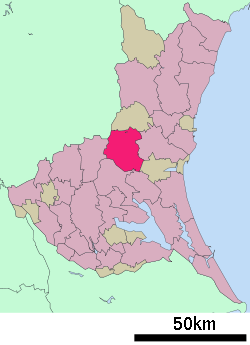Kasama, Ibaraki
| Kasama 笠間市 | ||
|---|---|---|
| City | ||
| ||
 Location of Kasama in Ibaraki Prefecture | ||
 Kasama Location in Japan | ||
| Coordinates: 36°23′N 140°14′E / 36.383°N 140.233°ECoordinates: 36°23′N 140°14′E / 36.383°N 140.233°E | ||
| Country | Japan | |
| Region | Kantō | |
| Prefecture | Ibaraki Prefecture | |
| Government | ||
| • Mayor | Shinjyu Yamaguchi (since April 2006) | |
| Area | ||
| • Total | 240.27 km2 (92.77 sq mi) | |
| Population (January 31, 2012) | ||
| • Total | 79,460 | |
| • Density | 330/km2 (860/sq mi) | |
| Time zone | Japan Standard Time (UTC+9) | |
| Symbols | ||
| - Tree | Cherry blossom | |
| - Flower | Chrysanthemum | |
| - Bird | Cettia diphone | |
| Address |
Kasama-chuo 3-2-1, Kasama City, Ibaraki Prefecture (茨城県笠間市笠間中央3丁目2番1号) 309-1792 | |
| Phone number | 81-(0)296-77-1101 | |
| Website | City of Kasama | |
Kasama (笠間市 Kasama-shi) is a city located in central Ibaraki Prefecture, Japan.
Kasama was once a castle town and post-station town during the Edo Period (1600–1868), and a shrine town of Kasama Inari Shrine in the Meiji Period (1868–1912). Stone quarrying is its main activity. Utensils for tea ceremony, flower vases, and sake containers called Kasama ware are produced here.[1]
As of 2003, the city had an estimated population of 29,776 and the total area was 131.61 km². Kasama officially achieved city status on August 1, 1958, after the towns of Kasama and Inada were merged.
On March 19, 2006, Kasama absorbed the towns of Tomobe and Iwama (both from Nishiibaraki District), and the new city hall is located at the former Tomobe Town Hall. Tomobe has become the new city's administrative center because it is more populous than the former Kasama.
As of January 31, 2012, the post-creation city has a total estimated population of 79,460, with 29,309 households and a population density of 330 persons per km². The post-creation area is now 240.27 km².
The name Kasama means "within the straw hat" (kasa 笠 - straw rice hat, ma 間 - within/inside). The center of the city is connected by many small towns, in the way that the center point of a straw hat is supported by the brim, thus the name. Also, Kasama is surrounded by mountains on all sides, so geographically speaking, the city resembles an upside-down straw hat.
Kasama has long been popular for its pottery, better known as kasama-yaki (笠間焼き). It is reddish-brown in color, with a black glaze. Up until recently, kasama-yaki was used to make things of daily use, like large pots (tsubo, 壺). Though this style was well known, it is now only made by a few kilns. Modern kasama-yaki is made in almost any style and color, from dinner ware and utensils, to works of art. It is noted for its fine quality, and thus Kasama is one of the most important artistic centers in the Kantō region. Kasama's pottery has a long history, which is connected with that of nearby Mashiko. Many people come from all over Japan and the world to study pottery with Kasama's masters.
This is a relatively small city that bursts with culture. It has an excellent modern art museum, the Kasama Nichido Museum of Art (笠間日動美術館) which opened on November 11, 1972. The elegant museum houses collections by a number of artists of international stature including Degas, Van Gogh, and Warhol. The city also houses the prefectural ceramics museum, which displays the works of Japanese Living National Treasures (人間国宝). Such artists include Hazan Itaya (板谷波山) and Kosei Matsui (松井康成). The house of calligrapher and ceramcist Kitaoji Rosanjin (北大路魯山人) is located here, and it has become a beautiful museum.
The annexed town of Iwama is known for having been the residence of Ueshiba Morihei, founder of Aikido, from 1942 until his death. Popular singer and songwriter Kyu Sakamoto also lived in Kasama as a child. Twice daily, chimes announce the time to the tune of his songs. His song "Ue o muite arukō" also plays at Tomobe train station to announce departures.
The Kasama Inari Shrine (笠間稲荷神社) is probably the most famous landmark. It is one of the three famous Inari Shrines in the country. It is the center of the city, and many festivals are celebrated there.
At the top of nearby Mount Sashiro (佐白山), lie the ruins of Kasama Castle (笠間城). It was a unique mountain castle, which overlooked the city. However, it was torn down during the Meiji Restoration, and only the stone base and a small shrine remain. The lookout tower was relocated to the grounds of a temple called Shinjo-ji (真浄寺), and sits on a hill overlooking the temple's main hall.
In the Inada (稲田) area, there is Sainen-ji (西念寺) temple, which was founded by the famous priest Shinran. Inada is also famous for its mikage stone, which is used all over Japan. One can see it everywhere in the plaza of Meiji Shrine in Tokyo.
References
External links
![]() Media related to Kasama, Ibaraki at Wikimedia Commons
Media related to Kasama, Ibaraki at Wikimedia Commons
- Kasama City official website (Japanese)
- Kasama Nichido Museum of Art (English)
| ||||||||||||||||||||||||||||||||||||